 Commercial differential scanning calorimeters used to measure enthalpy are often too expensive for colleges and universities. Although this project doesn't provide the extremely high performance of the commercial devices, it is a remarkably low-cost alternative that is more than sufficient for classroom use. The goals of the project were to create an instrument that has a wide enough temperature range to demonstrate measurement, a fairly accurate temperature resolution, and decent accuracy in measuring enthalpy energy. Most importantly, it had to be rugged to withstand use in the lab. An ATmega8 microcontroller handles temperature control and measurement functions. A PC serves as the user interface and display. This project made by Brian Millier got Honorable Mention in AVR 2004 DESIGN CONTEST.
Commercial differential scanning calorimeters used to measure enthalpy are often too expensive for colleges and universities. Although this project doesn't provide the extremely high performance of the commercial devices, it is a remarkably low-cost alternative that is more than sufficient for classroom use. The goals of the project were to create an instrument that has a wide enough temperature range to demonstrate measurement, a fairly accurate temperature resolution, and decent accuracy in measuring enthalpy energy. Most importantly, it had to be rugged to withstand use in the lab. An ATmega8 microcontroller handles temperature control and measurement functions. A PC serves as the user interface and display. This project made by Brian Millier got Honorable Mention in AVR 2004 DESIGN CONTEST.Wednesday, February 9, 2011
A Differential Scanning Calorimeter
 Commercial differential scanning calorimeters used to measure enthalpy are often too expensive for colleges and universities. Although this project doesn't provide the extremely high performance of the commercial devices, it is a remarkably low-cost alternative that is more than sufficient for classroom use. The goals of the project were to create an instrument that has a wide enough temperature range to demonstrate measurement, a fairly accurate temperature resolution, and decent accuracy in measuring enthalpy energy. Most importantly, it had to be rugged to withstand use in the lab. An ATmega8 microcontroller handles temperature control and measurement functions. A PC serves as the user interface and display. This project made by Brian Millier got Honorable Mention in AVR 2004 DESIGN CONTEST.
Commercial differential scanning calorimeters used to measure enthalpy are often too expensive for colleges and universities. Although this project doesn't provide the extremely high performance of the commercial devices, it is a remarkably low-cost alternative that is more than sufficient for classroom use. The goals of the project were to create an instrument that has a wide enough temperature range to demonstrate measurement, a fairly accurate temperature resolution, and decent accuracy in measuring enthalpy energy. Most importantly, it had to be rugged to withstand use in the lab. An ATmega8 microcontroller handles temperature control and measurement functions. A PC serves as the user interface and display. This project made by Brian Millier got Honorable Mention in AVR 2004 DESIGN CONTEST.Web-based AVR Interface using AT90S8535

Project description:
In the vein of today’s trends to embed networking cababilities into simple appliances, our project implements a webpage interface for the Atmel AVR microcontroller. One of the original motivations of this project was to develop a low-level network interface for the Atmel device, specifically by controlling an ISA network card to transmit UDP packets across the Internet. We greatly modified our original plans once we found out about the SitePlayer device.
Link : Web-based AVR Interface using AT90S8535
In the vein of today’s trends to embed networking cababilities into simple appliances, our project implements a webpage interface for the Atmel AVR microcontroller. One of the original motivations of this project was to develop a low-level network interface for the Atmel device, specifically by controlling an ISA network card to transmit UDP packets across the Internet. We greatly modified our original plans once we found out about the SitePlayer device.
Link : Web-based AVR Interface using AT90S8535
Monday, February 7, 2011
The Autonomous Tank using AT90S8515

Project description:
Here is ,another cool project from course ee476 Cornell university, autonomous vehicle, “Homer”, which can stroll around an environment without getting stuck at obstacles. That implies that it need a robust algorithm that tells the vehicle how to steer when it gets into different obstacle situations. The goal would be to demonstrate a vehicle that will run by itself and not get stuck or bump into any obstructions.
Link : The Autonomous Tank using AT90S8515
ATir AVR IR Keyboard Interface

Link : ATir AVR IR Keyboard Interface
Labels:
ATir AVR IR Keyboard Interface
Sunday, February 6, 2011
The ATmega8 microcontroller-based AVRcam

John Orlando and Brent Taylor from US has made a extradionary application based on AVR microcontroller that is The ATmega8 microcontroller-based AVRcam. It is a stand-alone image-processing engine that's well suited for robotics applications. The impressive AVRcam can track eight objects of eight different user-defined colors at 27 frames per second. The compact, low-power design provides a high-performance system that enables you to see your mobile robot's environment.
A user interface displays the following image information in real time: the number of currently tracked objects as well as the color, center point, and bounding box of each object. A PC-based application provides a platform to configure the system. In addition, the application allows you to take photographs with the AVRcam. No wonder if This Application won AVR 2004 Design Contest.
Link : Abstrak | Email | source
Automatic Egg Incubator based on AVR microcontroller

The easy-to-use ATmega32-based Automatic Egg Incubator facilitates the proper hatching of healthy birds. This idea implemented by Niyaz K. Zubair from India. Two digital thermometer chips serve as dry and wet electronic thermometers. The LCD shows the real-time status of the system, which rotates the eggs and monitors variables such as temperature, aeration, and humidity. This project got HONORABLE MENTION category in AVR 2004 Design Contest.
Editorial by Bizon
Link : Abstrak | Source
Saturday, February 5, 2011
AVR Electronic Metronome
If you learn a music instrument, definetely you know about metronome. A metronome is a device musicians use to maintain tempo. It generates a clicking sound at a steady rate that is set the user. Traditional mechanical metronomes use a windup spring and a dual-pendulum arm to produce the clicks. Michael Kirkhart from U.S. has design Electronic metronomes that offer additional functionality, such as programmable beats per measure, measure counting, and distinctive sounds for the first beat of the measure. But the sound of electronic metronomes can be grating. The ATmega16 microcontroller-based AVR Electronic Metronome improves upon the commercial competition with a rich set of sophisticated features and tuneful digital sound options.
Editorial by Bizon
Link : Abstrak | source
Editorial by Bizon
Link : Abstrak | source
Labels:
AVR Electronic Metronome
PIC Mini GPS Logger
This small PIC based GPS logger used San Jose Navigation FV-M8 GPS module. It allow you to stores coordinates, altitude, and speed into an EEPROM. Then a Delphi based windows software converts EEPROM stored data into .kml (Google Earth format). The system equipped with MCU PIC 16F876 to control FV-M8 GPS module, EEPROM, and interfacing to PC. You can use this project for snowboarding, FPV flights, trial bike and hiking logger.
Download : hex (16F876) | Windows GPS Logger | Schematic (eagle)
Download : hex (16F876) | Windows GPS Logger | Schematic (eagle)
Labels:
PIC Mini GPS Logger
Universal remote using microcontroller AVR AT90S8535
Project description:
A universal remote is a common everyday household appliance. Used to do everything from TV/Video/Cable to ceiling fan control, this project is a extremely versatile product. We planned to have a 32-button remote that could replicate the IR characteristics of a VCR & TV remote control.
Link : Universal Remote using Microcontroller AVR AT90S8535
Friday, February 4, 2011
Automatic Plant Feeder
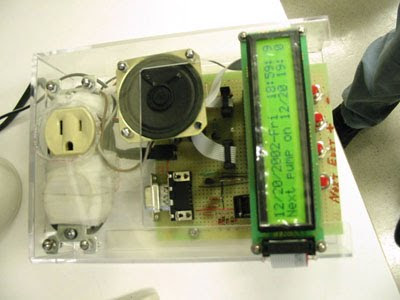
To display the time and system states, it use 24x2 LCD. A speaker is used for alarming and making sounds. While push buttons used to change the system states by user. A relay is used to control the AC of the water pump with a DC signal from the processor. For feed pattern, You can setting it up any time.
Tags: Plant feeder, Automatic, MCU project src
Labels:
Automatic Plant Feeder
AVR Electronic Humidor

Tag : Humidity Project, Temperature controller, AVR project source
Labels:
AVR Electronic Humidor
Thursday, February 3, 2011
AVR Wireless Streaming Radio

Gary Dion said that the radio can be controlled over Ethernet and also IR transmitter. The firmware in the project is written in C. You can download the source code here and router shell script. The project inspiration come from Jeff Keyzer.
Labels:
AVR Wireless Streaming Radio
CAN-Servo Controller

This dsPIC30F4011-based servo (position) controller receives commands via a CAN. If a DC motor does not have a rotary encoder, you can plug a contactless magnetic rotary encoder (CMRE) module into the board (via two SIL connectors) and provide (in a self-contained unit) rotary encoder and position control.
Mariano Lizarraga Fernandez, the designer, explains that the board in this project also fully configurable via a CAN network and no power-cycle is necessary for any change to take effect. The board has programmed PID controllers with selectable parameter from user. The controller gains, maximum and minimum pwm commands, and device ID are also configurable. All configuration values are stored in the dsPIC's EEPROM so once it is configured at the full contempt of the end-user, no more changes are required.
Download:
Project Documentation and Schematic (zip)
Mariano Lizarraga Fernandez, the designer, explains that the board in this project also fully configurable via a CAN network and no power-cycle is necessary for any change to take effect. The board has programmed PID controllers with selectable parameter from user. The controller gains, maximum and minimum pwm commands, and device ID are also configurable. All configuration values are stored in the dsPIC's EEPROM so once it is configured at the full contempt of the end-user, no more changes are required.
Download:
Project Documentation and Schematic (zip)
Labels:
CAN-Servo Controller
Wednesday, February 2, 2011
dsPIC MiniTron Amplifier
 The MiniTron is a high end vacuum tube stereo amplifier with efficiency, distortion, and power output enhancements provided by some unique circuitry featuring a dsPIC30F2023 controller IC. The dsPIC is used in this project to create a tracking buck converter whose output voltage tracks the audio signal. The unique SMPS resources in these IC’s do most of the "hard stuff" usually required in an SMPS design, leaving ample processing power available for other activities.
The MiniTron is a high end vacuum tube stereo amplifier with efficiency, distortion, and power output enhancements provided by some unique circuitry featuring a dsPIC30F2023 controller IC. The dsPIC is used in this project to create a tracking buck converter whose output voltage tracks the audio signal. The unique SMPS resources in these IC’s do most of the "hard stuff" usually required in an SMPS design, leaving ample processing power available for other activities.These IC’s and the Avago galvanic isolators are truly the "enabling technology" for this project. The controller IC is also used to perform system health checks, and set the operating points of the individual vacuum tubes. This allows total system programmability, offering several possible preset operating modes.
© George Anderson
Download
Project Documentation
tag : Tube Stereo Amplifier, Audio, dsPIC projec
Labels:
dsPIC MiniTron Amplifier
PIC based Animation Tile Display

John Peterson, project designer, said that the display is completely reconfigurable. If the pieces are left in the tray, the animation can be updated continuously over the Ethernet connection. If the tiles are removed from the tray, they’ll display the animation for several hours with their own re-chargeable battery power. Once the animation is synchronized and running on the tiles, user can pick them up and place them anywhere.
Download:
Project Documentation, Source Code and Schematic(zip)
tag : Display, LED, project, PIC, PIC24FJ64GA002, animation, puzzle
Labels:
PIC based Animation Tile Display
PIC Based GPS to SD-Card Data Logger

The data from the GPS is logged every second with the raw NMEA sentences being written to the SD card. The data written to the card is the GSA, GGA, RMC and GSV sentences which by excluding the carriage returns this should never exceed 512 bytes per second. The data contains:
- GGA - 78 bytes - time, fix, lat, long, altitude, horizontal dilution of precision.
- GSA - 69 bytes - fix (none, 2D, 3D), satellites used, dilution of precision.
- RMC - 78 bytes - time, lat, long, speed, course, date.
- GSV - 74 bytes - satellite information (4 messages).
Download : schematic and source code
related serch : Microcontroller Circuit Project, GPS, SD Card, Data Logger, PIC (src)
Monday, January 31, 2011
PIC MIDI expander with old ISA-BUS Soundcard

The software responds to MIDI commands on Channel 1. The sounds are generated by the FM synthesizer built in the soundcard. The power is derived from two low-cost wall transformers (see picture) with variable output, set to 9V (the output is close to 12V).
Download :
Source code and schematic
search term : Midi expander, ISA BUS, Microcontroller PIC project (src)
Infrared Thermometer Module

tags: Electonic Module, Infrared Thermometer (src)
Labels:
Infrared Thermometer Module
Electronic Project : AVR Lux Meter

We can build ourselves Lux meter using electronic components. At the detection of light we use photo diode. However, there is a difference between the spectra simple answer photo diode silicon and the naked eye, it can not be used for lux meter. Some photo diodes for lighting have a sensor compensation color filter on the window to correct its response spectra.
In this project, Photo-diode current results light that is well proportional to the light input power when used in short fashion. In this lux meters, the output current is converted into a voltage converter with an IV, he is caught by a micrcontroller AVR and displayed in terms of lux. The ppamp U1 in the circuit diagram that acts IV conversion circuit and its conversion becomes 50mV / μ A, in accordance with a record of comments R5. The capacitor C5 is to obtain the correction, it cancels Ct of the photo diode (about 200 pF). In this case, greater capacity in May rather be 220 pF because the high frequency signal is not necessary. The lux meter is powered by a 9V battery.
Download schematic, document, firmware (zip) here
[source]
Sunday, January 30, 2011
USB Audio Digital to Analog Converter
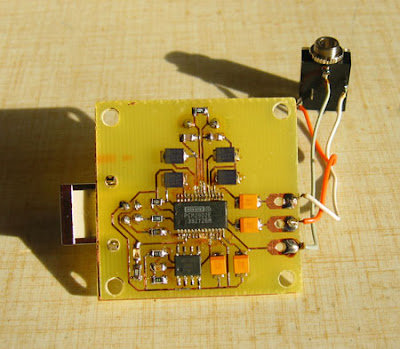
Schematics is from datasheet of PCM2902. Circuit includes DAC and ADC, SPDIF output and input and HID part with 3 buttons for MUTE, VOL+ and VOL-. I used only DAC part. Other parts are not used. For high quality playback is needed to use external low-drop voltage stabiliser for DAC part. I used LP2951CM which was available at local store. Output voltage is set to about 3.7V with two resistors. Circuit board is designed regarding to good ground placement and separating of analog and digital ground. These ground are connected in one point at USB connector.
[source]
Hummer RC Truck, AT90S8535

For our final project, we decided to enhance the controls of a Hummer RC truck. Our main objective was to demonstrate that an Atmel microcontroller together with basic hardware building blocks can replace all of the car’s original circuitry. Improving the RC truck’s handling involved adding analog control over steering and speed.
The original construction of the car hindered this idea and forced us to resort to some mechanical engineering (mounting a servo) to resolve the problem! Overall, the project was a great deal of fun and involved a lot of tinkering with hardware (including dangerous flirtations with nearly exploding power transistors!)
Link : Hummer RC Truck, AT90S8535
The original construction of the car hindered this idea and forced us to resort to some mechanical engineering (mounting a servo) to resolve the problem! Overall, the project was a great deal of fun and involved a lot of tinkering with hardware (including dangerous flirtations with nearly exploding power transistors!)
Link : Hummer RC Truck, AT90S8535
Labels:
AT90S8535,
Hummer RC Truck
GPIB to USB converter Using PIC
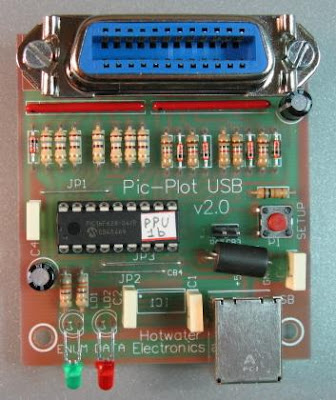
PIC-plot now goes to USB! A perfect low cost solution to quickly get screen plots of your GPIB instrument on your laptop PC without complex software. It emulates the HP7470A operation on the GPIB side, and outputs the HP-GL data at the USB port to be read and stored on the PC by any capturing software. GPIB addresses and other set-and-forget parameters can be configured by a simple Setup menu, then no Dip-switches are used. Power is taken from the USB port to simplify cabling and get rid of a DC adaptor.
The operation of this interface is not just limited to digital plotter emulation: any data intended to be received by a GPIB Device (addressable or listener only) can be captured from the instrument and brought out to the USB port, including raw measurement arrays or rasterized data for a graphic printer. It is based on a PIC16F628 microcontroller and an FT232R chip. PCB size is just 57x64mm.
[source]
The operation of this interface is not just limited to digital plotter emulation: any data intended to be received by a GPIB Device (addressable or listener only) can be captured from the instrument and brought out to the USB port, including raw measurement arrays or rasterized data for a graphic printer. It is based on a PIC16F628 microcontroller and an FT232R chip. PCB size is just 57x64mm.
[source]
Labels:
GPIB to USB converter Using PIC
Saturday, January 29, 2011
LED Fader Project

Download :
Source Code and Documentation
tag : LED, AVR Microcontroller Project (src)
Labels:
LED Fader Project
The Ethernet Shield For Arduino
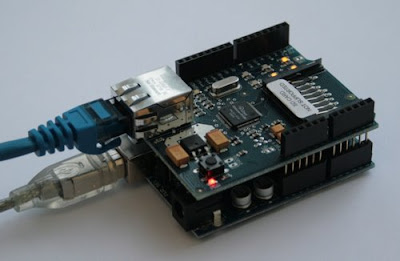
Download : Documentation and guide
related search : Arduino project, ethernet shield, electroonic project (src)
Labels:
The Ethernet Shield For Arduino
Microcontroller based Photoplotter
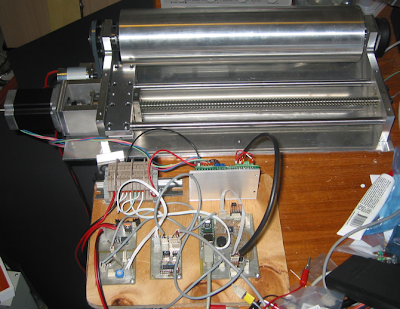
A photoplotter is a printing device that exposes light to a photo sensitive film to produce output. The film is then developed like traditional photos to get the result. There are 2 types of photoplotter, vector type and raster type. Vector plotters move the exposure light anywhere in 2D space to create the image. Need a line from point A to B? No problem, just move from A to B. These are similar to old style pen plotters. Raster plotters, are more like a dot matrix printer, sending out one line of dots, then moving to the next to create an image.
related search : Elelctronic circuit, Photo plotter, Microcontroller project (src)
Wednesday, January 26, 2011
Microcontroller based Photoplotter
A photoplotter is a printing device that exposes light to a photo sensitive film to produce output. The film is then developed like traditional photos to get the result. There are 2 types of photoplotter, vector type and raster type. Vector plotters move the exposure light anywhere in 2D space to create the image. Need a line from point A to B? No problem, just move from A to B. These are similar to old style pen plotters. Raster plotters, are more like a dot matrix printer, sending out one line of dots, then moving to the next to create an image.
related search : Elelctronic circuit, Photo plotter, Microcontroller project (src)
related search : Elelctronic circuit, Photo plotter, Microcontroller project (src)
Burning the Bootloader without external AVR-Writer

tags : Arduino Diecimila, AVR, Digital Electronic (src)
MAX3420 - USB Peripheral Controller

Download : PCB and Circuit in Eagle
related search : Digital Electronic Project, USB Controller (src)
Tuesday, January 25, 2011
RF remote control using microcontroller AVR
Using remote control make our work more easier. like turn off Air conditioner, change channel TV, play your home theater and more. There are many type of remote control like Infrared, Radio Frequency, SMS and more. To control device behind the wall like garage door you can only use Radio Frequency remote control. Because the other can not bypass the wall.
Here is RF Remote control using microcontroller created by serasidis. There are two part in this electronic project : transmitter and receiver. The transmitter is constituted by AT90S2323 microcontroller and TLP434 RF transmitter module at 418MHz. the transmitter designed for battery economy use and safe transmition of the data. The receiver constituted by RF receiver module RLP434A at 418MHz, the microcontroller AT90S2313 and the 2 relays with can handle any electric (or electronic) device up to 10 Amps (the contacts of my relays are 10Amp at 250Volts).For antenna you can use a cable 30 - 35cm long.
Download here for documentation, firmware, source code and schematic.
[link]
Here is RF Remote control using microcontroller created by serasidis. There are two part in this electronic project : transmitter and receiver. The transmitter is constituted by AT90S2323 microcontroller and TLP434 RF transmitter module at 418MHz. the transmitter designed for battery economy use and safe transmition of the data. The receiver constituted by RF receiver module RLP434A at 418MHz, the microcontroller AT90S2313 and the 2 relays with can handle any electric (or electronic) device up to 10 Amps (the contacts of my relays are 10Amp at 250Volts).For antenna you can use a cable 30 - 35cm long.
Download here for documentation, firmware, source code and schematic.
[link]
RF and IR Remote Control
This PIC based remote control allow you to control up to 8 devices by this easy constructable remote control. The project very flexible you can use it as radio remote control or infrared remote control, depending on the components. Each device output can be configured to be momentary (turned on while you press the button) or latched. Latched outputs can be toggled on/off by one button per channel, or turned on and off by two buttons per channel.
Labels:
RF and IR Remote Control
PS to USB Joystick Converter
If you have PS 1 or PS 2 joystick and you want use it for USB. Well this microcontroller project could resolve your problem now. PS2USB converts two Playstation 1 or Playstation 2 converter into usb josysticks. It also features the Dance Pad Code (Up+START+SELECT), so that it can be used in DDR games (tested with Stepmania). Works under Linux, Mac OSX, Windows.
source code and schematic
search term : PS to USB, Converter, Microcontroller Project (src)
note : no picture for the project, i just replace it with analog PS 1 joystickDownload :
source code and schematic
search term : PS to USB, Converter, Microcontroller Project (src)
Labels:
PS to USB Joystick Converter
Monday, January 24, 2011
AVR XMEGA

"The new AVR XMEGA™ family from Atmel brings 8/16-bit microcontrollers up to a new level of system performance. Increased focus on system performance is important because more and more 8/16-bit microcontroller families do not meet today’s requirements. Requirements for higher embedded performance combined with reduced cost, size and power consumption mandate new microcontrollers designed especially to combine and offer all these requirements in the best possible way. With AVR XMEGA Atmel is the reference for 8/16-bit microcontrollers."
AVR XMEGA devices include:
- 2nd generation of picoPower technology
- Innovative Event System for fast, CPU independent inter-peripheral communication
- 4-channel DMA Controller boosts MCU performance
- 100% predictable timing
- Fast 12-bit ADC and DAC
- Fast Cryptography support for AES and DES
Electronic Tools : Weller WLC100 Soldering Station

The Weller WLC100 Soldering Station includes everything you need to start using solder to join metals and create efficient, electrical connections. Designed with the hobbyist and the do-it-yourself enthusiast in mind, this kit features a high-quality, lightweight pencil iron with variable power control, a cushioned foam grip with a replaceable heating element, and a safety guard iron holder. And it’s from Weller, the world leader in soldering since 1945.
Labels:
Electronic Tools
MC9S08GT60 Virtual Interactive Boxing
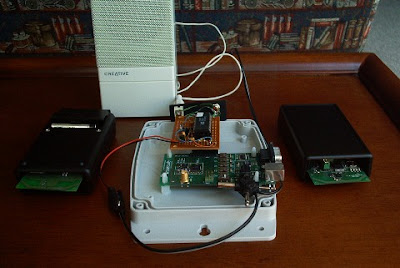
Download :
Download Project | View Abstract
Tags : MC9S08GT60 microcontroller, MC13192 RF transmitter, Microcontroller Project
Sunday, January 23, 2011
LCD2USB : Connect LCD to PC via USB

Download : Schematic, Souce Code
tags : LCD, USB, AVR, Microcontroller, Interfacing (src)
Labels:
Connect LCD to PC via USB
New AVR Microcontroller for Smart Card Reader Applications

The AT90SCR100 offers a comprehensive set of interfaces such as ISO7816 (Class A,B,C supported), USB full Speed 2.0 device and host, USART and TWI to address any applications that interface to synchronous, asynchronous and USB smart cards. In addition, a SPI serial interface plus a dedicated High Speed SPI interface (up to 20Mbps at 20MHz) have been implemented. Respectively combined with an RF front end and/or with a fingerprint sensor, the AT90SCR100 is ideally suited to contactless and/or Biometric reader applications. With its 38 GPIOs in its high pin count configuration (64 pin package), it can also address all USB Keyboards integrating the smart card reader functionality.
Availability and Pricing
Samples for the AT90SCR100 are available now. Packages are available in 32-pin QFN, 64-pin QFN and 64-pin QFP. Volume production will start in May 2009. Prices start at US$ 3.00 for the 64 pin count version and at US$ 1.90 for the 32 pin package in 10,000 quantities.
related search : news, atmel, microcontroller, smart card reader, avr (src)
Card Reader using Microcontroller

- A reader to capture digital characters from the card
- A RISC microcontroller to store data and check for errors
- A display to relay the magstripe contents to the viewer
The Magstripe (Track 2) Reader project can be used to view numerics stored a magnetic data card. Although there is no writeback ability, the device is very useful as a card debugger. The treatise will use an LCD character display to relay this data to the user. The circuit uses an AVR microcontroller and can modified to work with similar RISC controllers.Although the card reader can't write back to magnetic card, I guess this is a one of good reference to learn how card reader work. For download the reference clik here (zip file)or visit this link
Thanks to Brady Mayes for great card reader based on microcontroller.
Saturday, January 22, 2011
Project : Radio Controlled Clock with USB

Download : schematic and Firmwire
tags : Microcontroller AVR Project, radio-controlled clock receiver, USB (src)
Arduino Duemilanove Project Board

Download : Eagle Files (zip) and Schematic (PDF)
related search : Microcontroller Board, Arduino, ATmega168 (src)
Labels:
Arduino,
ATmega168,
Microcontroller Board
LM35 and TL431 Automatic Temperature Control

Download : schematic, layout and PCB (pdf)
related search : Electronic circuit project, automatic application, temperauter controller, LM 35 (src)
Friday, January 21, 2011
Computer Controlled Battery Manager
BattMan II is a computer controlled battery manager, intended for typical rechargeable batteries used by R/C and electronics hobbyists, as well as various consumer product batteries.
BattMan II has the following capabilities:
releated search: Electronic Circuit Project, Battery manager (src)
BattMan II has the following capabilities:
- Works with Nickel-Cadmium (NiCd), Nickel-Metal-Hydride (NiMH), Lithium-Ion (Li-Ion), Lithium-Polymer (LiPo), Lithium-Nano-Phosphate (LiNP), and Lead-Acid (Pb-Acid) batteries of 1.2 to 14.7 Volts.†
- Discharges batteries to measure capacity at rates of 130mA to 2A.
- Charges at rates of 130mA to 1.3A.†
- Automatically performs repeated discharge/charge cycles to break in new batteries, or erase NiCd voltage depression in old ones.
- Measures internal resistance.
- Monitors self-discharge.
- Real time graphical display lets you see problems like mismatched cells.
- Keeps a log of all operations performed, which can be imported into any spreadsheet program.
- Saves graphs of charge, discharge, auto-cycle, and monitor operations.
- Connects via parallel port to any PC running Microsoft Windows (95, 98, ME, 2000, XP, or Vista).
- Operating software, complete with source code, is available to download.
releated search: Electronic Circuit Project, Battery manager (src)
Controlling LCD using BASCOM and AVR
Bascom can handle the two main types of liquid-crystal displays: alphanumeric and graphic. For the time being we will concern ourselves with the most common alphanumeric type. This type of LCD can display characters, numbers and special characters. The most common type of alphanumeric LCD uses a Hitachi HD44780 as display controller. When you are uncertain about what type of display you are holding in your hands, simply look at the chip designations on the back. If one of these says HD44780 you're safe.
Fortunately, the default is set to LCD type 16*2. This is the most common LCD with two lines and 16 characters per line. HD44780 type LCD's have eight datalines, but they can be controlled in a more economical way by using the four 'upper' lines. This saves four i/o pins on your controller. This is the default (4-bit bus mode) in the options window. Sending data in the 4-bit bus mode of course takes two writes for each 8-bits to send. If you really need the LCD to be as fast as possible (and you seldom do) you will have to choose the 8-bit bus mode.
source : qsl.net
Fortunately, the default is set to LCD type 16*2. This is the most common LCD with two lines and 16 characters per line. HD44780 type LCD's have eight datalines, but they can be controlled in a more economical way by using the four 'upper' lines. This saves four i/o pins on your controller. This is the default (4-bit bus mode) in the options window. Sending data in the 4-bit bus mode of course takes two writes for each 8-bits to send. If you really need the LCD to be as fast as possible (and you seldom do) you will have to choose the 8-bit bus mode.
source : qsl.net
Thursday, January 20, 2011
AVR Frequency Counter

[Link]
Labels:
AVR Frequency Counter
Logging System & Data Acquisition

"The status and temperature date saved to PC via serial communication. Here 8 temperature sensors are connected(4 shown in diagram for simplicity). values of all the sensors are sent serially by AT89C51 to pc. Software "DAQ System " takes these values and show them on its front panel, and also logs them to the data base "daq.mdb" .we can set some parameters like set point , low limit ,and high limit . when temperature of some sensor increases beyond set point ,the heater connected to controller (specific for that sensor) will be turned OFF( ON in opposite case ).High limit and low limits are for alarm. when temperature goes above high limit or below low limit the alarm will be turned on."
For complete reference, source code, Schematic, you can download here.
[Link]
Labels:
Data Acquisition,
Logging System
Wednesday, January 19, 2011
Simple RS 232 Level Converter
 When you need connect your Microcontroller Project to COM port in PC you need RS 232 converter. There are many chip to solve the problem like MAX232, DS275 etc. But if you need simple and chep for RS 232 converter, i though this circuit will be usefull for you. The design made by Wichit Sirichote.
When you need connect your Microcontroller Project to COM port in PC you need RS 232 converter. There are many chip to solve the problem like MAX232, DS275 etc. But if you need simple and chep for RS 232 converter, i though this circuit will be usefull for you. The design made by Wichit Sirichote.
"A circuit diagram shown above was used two small signal transistor, NPN and PNP transistors. Dash line separate transmitter and receiver circuit. For those who need only transmitter circuit can use above circuit (and GND (5) signal ). Technically the RS232C is -3V to -12V for logic '1' and +3V to +12V for logic '0'. The transmitter circuit uses PNP transistor, BC557. While in mark state the TxD signal is logic '1', Q1 turns off. TxD (pin3) then provides -9V (depends on what converter chip being used for COM1, say) to RxD (pin2). For space state, TxD control signal then becomes logic '0', which turns on Q1, the approx. +5V is then fed to RxD (pin2). With this method, while sending data has being made, TxD (pin3) must stable at -9V, say"There also some modification from above circuit. For more detail you can download here.
[link]
Simple Darkness Sensing LED
 Evil Mad Scientists have create cool and simple Darkness Sensing LED ever. It's only need few component: a CR2032 lithium coin cell (3 V). LED, an LTR-4206E phototransistor, a 2N3904 transistor, and a 1 k resistor. You can choose it for your first project during learning electronic.
Evil Mad Scientists have create cool and simple Darkness Sensing LED ever. It's only need few component: a CR2032 lithium coin cell (3 V). LED, an LTR-4206E phototransistor, a 2N3904 transistor, and a 1 k resistor. You can choose it for your first project during learning electronic.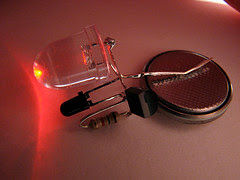
"When light falls on the phototransistor, it begins to conduct up to about 1.5 mA, which pulls down the voltage at the lower side of the resistor by 1.5 V, turning off the transistor, which turns off the LED. When it’s dark, the transistor is able to conduct about 15 mA through the LED. So, the circuit uses only about 1/10 as much current while the LED is off. One thing to note about this circuit: We’re using a red LED. That’s because the voltage drop across the transistor allows less than the full 3 V across the LED. The full three volts is really only marginal for driving blue LEDs anyway, so two-point-something really doesn’t cut it."[link]
Labels:
Simple Darkness Sensing LED
Simple RS 232 Level Converter

When you need connect your Microcontroller Project to COM port in PC you need RS 232 converter. There are many chip to solve the problem like MAX232, DS275 etc. But if you need simple and chep for RS 232 converter, i though this circuit will be usefull for you. The design made by Wichit Sirichote.

[link]

There also some modification from above circuit. For more detail you can download here.
"A circuit diagram shown above was used two small signal transistor, NPN and PNP transistors. Dash line separate transmitter and receiver circuit. For those who need only transmitter circuit can use above circuit (and GND (5) signal ). Technically the RS232C is -3V to -12V for logic '1' and +3V to +12V for logic '0'. The transmitter circuit uses PNP transistor, BC557. While in mark state the TxD signal is logic '1', Q1 turns off. TxD (pin3) then provides -9V (depends on what converter chip being used for COM1, say) to RxD (pin2). For space state, TxD control signal then becomes logic '0', which turns on Q1, the approx. +5V is then fed to RxD (pin2). With this method, while sending data has being made, TxD (pin3) must stable at -9V, say"
[link]
Labels:
Simple RS 232 Level Converter
Subscribe to:
Posts (Atom)








